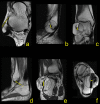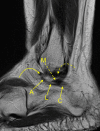The double fascicular variations of the anterior talofibular ligament and the calcaneofibular ligament correlate with interconnections between lateral ankle structures revealed on magnetic resonance imaging
- PMID: 33247207
- PMCID: PMC7695848
- DOI: 10.1038/s41598-020-77856-8
The double fascicular variations of the anterior talofibular ligament and the calcaneofibular ligament correlate with interconnections between lateral ankle structures revealed on magnetic resonance imaging
Abstract
The anterior talofibular ligament and the calcaneofibular ligament are the most commonly injured ankle ligaments. This study aimed to investigate if the double fascicular anterior talofibular ligament and the calcaneofibular ligament are associated with the presence of interconnections between those two ligaments and connections with non-ligamentous structures. A retrospective re-evaluation of 198 magnetic resonance imaging examinations of the ankle joint was conducted. The correlation between the double fascicular anterior talofibular ligament and calcaneofibular ligament and connections with the superior peroneal retinaculum, the peroneal tendon sheath, the tibiofibular ligaments, and the inferior extensor retinaculum was studied. The relationships between the anterior talofibular ligament's and the calcaneofibular ligament's diameters with the presence of connections were investigated. Most of the connections were visible in a group of double fascicular ligaments. Most often, one was between the anterior talofibular ligament and calcaneofibular ligament (74.7%). Statistically significant differences between groups of single and double fascicular ligaments were visible in groups of connections between the anterior talofibular ligament and the peroneal tendon sheath (p < 0.001) as well as the calcaneofibular ligament and the posterior tibiofibular ligament (p < 0.05), superior peroneal retinaculum (p < 0.001), and peroneal tendon sheath (p < 0.001). Differences between the thickness of the anterior talofibular ligament and the calcaneofibular ligament (p < 0.001), the diameter of the fibular insertion of the anterior talofibular ligament (p < 0.001), the diameter of calcaneal attachment of the calcaneofibular ligament (p < 0.05), and tibiocalcaneal angle (p < 0.01) were statistically significant. The presence of the double fascicular anterior talofibular ligament and the calcaneofibular ligament fascicles correlate with connections to adjacent structures.
Conflict of interest statement
The authors declare no competing interests.
Figures









References
-
- Uğurlu M, Bozkurt M, Demirkale İ, Cömert A, Acar Hİ, Tekdemir İ. Anatomy of the lateral complex of the ankle joint in relation to peroneal tendons, distal fibula and talus: a cadaveric study. Joint Dis. Related Surg. 2010;21(3):153–158. - PubMed
Publication types
MeSH terms
LinkOut - more resources
Full Text Sources

